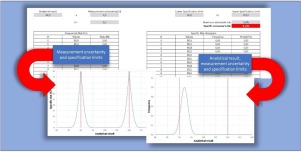当前位置:
X-MOL 学术
›
J. Pharmaceut. Biomed. Anal.
›
论文详情
Our official English website, www.x-mol.net, welcomes your feedback! (Note: you will need to create a separate account there.)
Frequentist approach for estimation of false decision risks in conformity assessment based on measurement uncertainty of liquid chromatography analytical procedures.
Journal of Pharmaceutical and Biomedical Analysis ( IF 3.4 ) Pub Date : 2020-02-25 , DOI: 10.1016/j.jpba.2020.113203 Luciana Separovic 1 , Felipe Rebello Lourenço 1
Journal of Pharmaceutical and Biomedical Analysis ( IF 3.4 ) Pub Date : 2020-02-25 , DOI: 10.1016/j.jpba.2020.113203 Luciana Separovic 1 , Felipe Rebello Lourenço 1
Affiliation

|
The measurement uncertainty (MU) related to analytical results can lead to false decisions in conformity assessment, such as accepting or rejecting incorrectly a medicine lot (consumer's and producer's risks, respectively). These risks can be global or specific. It is important to understand the different types of conformity decision risks, and the different approaches to estimate them to ensure the reliability of the analytical results. Thus, the aim of this work was to estimate the specific consumer's and producer's risks from the MU values of 64 liquid chromatography analytical procedures for antibiotic or antifungal assays, in order to evaluate their performances in conformity assessment. The specific risks of the analytical procedures were estimated by the frequentist approach following normal distribution using Microsoft Excel® software, and in addition a spreadsheet was created to be available as supplementary material to estimate specific risks by this approach. Moreover, the global risks of the analytical procedures were estimated using Bayesian approach, assuming a uniform scenario of production process. And finally, the estimation of specific risks by Bayesian and frequentist approaches was compared. Only 39 % of the evaluated analytical procedures had MU within the recommended. When the result is close to the specification limit, the risk can be significant, in such cases, a strategy is to adopt guard bands to reduce or expand the specification limits, minimizing the risks. The spreadsheet created shows the risk of false decision for a MU value, considering results within and outside the specification limits, allowing to verify the risk according to the analytical result obtained. The global risks values were practically equal to the expanded uncertainty values, as there is no tendency of the production process between lots within or outside the specification, but once the analytical result is known, the frequentist approach provides a more reliable risk estimate (specific risk). The specific risks estimated by Bayesian and frequentist approaches were divergent by the influence of the production process information on the first approach, which may overestimate or underestimate the consumer's and producer's risks regarding the frequentist approach. Failures in medicine conformity assessment can cause much damage, therefore, preventive actions such as developing, evaluating and/or optimizing analytical procedures, are essential in order to guarantee measurement uncertainties below or equal to the target and adopt routine strategies to minimize the risk of false decisions in conformity assessment.
中文翻译:

基于液相色谱分析程序测量不确定度的一致性评估中错误决策风险的常用评估方法。
与分析结果相关的测量不确定度(MU)可能导致合格评定中的错误决定,例如错误地接受或拒绝药品批次(分别是消费者和生产者的风险)。这些风险可以是全局风险,也可以是特定风险。重要的是要了解不同类型的合格决策风险,以及不同的估算方法,以确保分析结果的可靠性。因此,这项工作的目的是从用于抗生素或抗真菌测定的64种液相色谱分析程序的MU值中估算特定消费者和生产者的风险,以评估其在合格评定中的表现。在使用MicrosoftExcel®软件进行正态分布后,按照常客方法估算了分析程序的特定风险,此外,还创建了一个电子表格以用作补充材料,以通过该方法估算特定风险。此外,假设生产过程是统一情景,则使用贝叶斯方法估算分析程序的全球风险。最后,比较了贝叶斯方法和常识性方法对特定风险的估计。在评估的分析程序中,只有39%的MU在推荐范围内。当结果接近规格极限时,风险可能会很大,在这种情况下,一种策略是采用保护带来减小或扩展规格极限,从而最大程度地降低风险。创建的电子表格显示了MU值的错误决策风险,并考虑了规格限制内外的结果,从而可以根据获得的分析结果验证风险。总体风险值实际上等于扩展的不确定性值,因为在规格内或规格外的批次之间没有生产过程的趋势,但是一旦分析结果已知,常压法便可以提供更可靠的风险估计(特定风险)。 )。贝叶斯方法和惯常方法估计的特定风险因生产过程信息对第一种方法的影响而有所不同,这可能会高估或低估消费者和生产者有关惯常方法的风险。
更新日期:2020-02-25
中文翻译:

基于液相色谱分析程序测量不确定度的一致性评估中错误决策风险的常用评估方法。
与分析结果相关的测量不确定度(MU)可能导致合格评定中的错误决定,例如错误地接受或拒绝药品批次(分别是消费者和生产者的风险)。这些风险可以是全局风险,也可以是特定风险。重要的是要了解不同类型的合格决策风险,以及不同的估算方法,以确保分析结果的可靠性。因此,这项工作的目的是从用于抗生素或抗真菌测定的64种液相色谱分析程序的MU值中估算特定消费者和生产者的风险,以评估其在合格评定中的表现。在使用MicrosoftExcel®软件进行正态分布后,按照常客方法估算了分析程序的特定风险,此外,还创建了一个电子表格以用作补充材料,以通过该方法估算特定风险。此外,假设生产过程是统一情景,则使用贝叶斯方法估算分析程序的全球风险。最后,比较了贝叶斯方法和常识性方法对特定风险的估计。在评估的分析程序中,只有39%的MU在推荐范围内。当结果接近规格极限时,风险可能会很大,在这种情况下,一种策略是采用保护带来减小或扩展规格极限,从而最大程度地降低风险。创建的电子表格显示了MU值的错误决策风险,并考虑了规格限制内外的结果,从而可以根据获得的分析结果验证风险。总体风险值实际上等于扩展的不确定性值,因为在规格内或规格外的批次之间没有生产过程的趋势,但是一旦分析结果已知,常压法便可以提供更可靠的风险估计(特定风险)。 )。贝叶斯方法和惯常方法估计的特定风险因生产过程信息对第一种方法的影响而有所不同,这可能会高估或低估消费者和生产者有关惯常方法的风险。



























 京公网安备 11010802027423号
京公网安备 11010802027423号